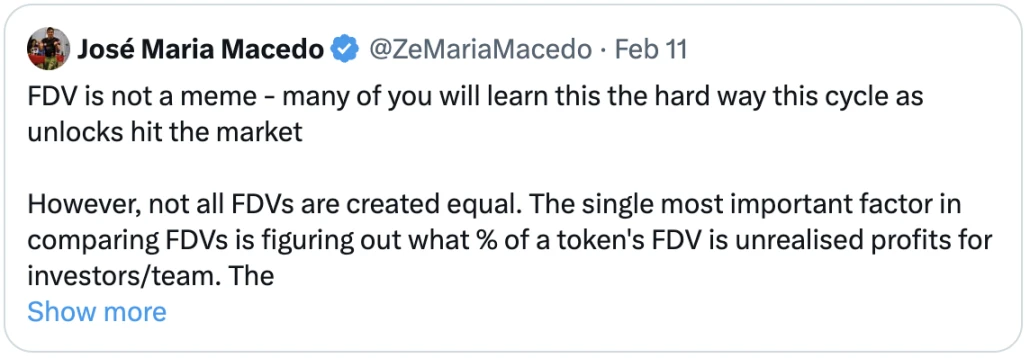CEO Delphi Labs: FDV bukan meme, unlocking tinggi tidak berarti proyek akan direset ke nol
Artikel asli oleh: José Maria Macedo
Terjemahan asli: TechFlow
FDV is indeed not a meme, and since this post was published, I have been talking to OTC brokers to try to understand the secondary market structure for the assets I shorted. The findings were illuminating, so I thought I would share them with you.
All in all, I dont think these are bullish unlocks.
Many of these assets have active sellers, but few are bidding below 70% of the market price (we are talking about a standard SAFT or Simple Agreement for Tokens with a 1 year cliff and 2/3 year vesting period).
In terms of volume, my rough estimate based on conversations with various brokers is that total SAFT volume is about $100 million, which is pretty much a done deal considering these assets have tens of billions of dollars in unrealized gains that will be unlocked over the next few years.
To put it simply, what Bullish Unlock wants to see is the lowest possible unrealized gain to market cap ratio, as explained in the linked article.
Most tokens are sitting on massive unrealized gains from the team (0 cost basis) and early investors (you can calculate this yourself using tools like cryptorank.io).
Coupled with the extremely low floating rate (generally 5-15%), the transaction price of most projects is 4-8 times the market value of unrealized profits, that is, the total circulating market value of the project has 4-8 times the unrealized profits.
Assuming a 2 year timeframe from the Cliff Day, this means that the entire market cap worth of assets will be unlocked every 3-6 months. This will be hard to attract buyers, especially if their alternative beta exposure is to memecoins and other assets that are not in oversupply.
One way to reduce this effect (besides increasing the initial float) is high pre-issuance secondary trading volume, ideally as close to the current market price as possible.
This helps reset the cost basis of unlocked tokens and radically reduce the unrealized gain to market cap ratio (e.g. the now famous Multicoin SOL assist leading to the first unlock)
Unfortunately, I don’t see that happening in the OTC market.
Relatedly, I am trying to understand market structure. I don’t want to single out specific assets, but there are a lot of assets that have the following characteristics
-
Extremely high unrealized gains to market value ratio;
-
Even at ~70% below market price there is no secondary demand;
-
Funding rates on Binance remain positive, with open interest reaching eight figures;
Who would covet this stuff on a CEX but not be interested in buying it on the secondary market at a 70%+ discount?
My assumption is just that there are special frictions on both the buyer and seller sides.
I dont know a lot about the buy side, but I think if theyre spending money to be long these things, theyre likely unsophisticated retail gamblers who dont understand vesting schedules or OTC desks.
Sellers may include:
a) Founders/Team, who have more than 90% of their new coins in the locked token bag and therefore have no collateral or tendency to short;
b) Investors in venture capital funds who cannot or do not have a setup to short assets on CEX;
That’s why the opportunity to short these assets and profit from them still exists.
By the way, contrary to what the CT doomsayers tell you, this does not mean that all cryptocurrencies are scams, or even that all assets with high market capitalizations of unrealized gains will go to zero.
I am very bullish on cryptocurrencies and believe there will be some category winners that rise through their unlocking because they do have real-world applications.
However, there will be long tail assets that “go to zero.” This is natural and what you would expect in an asset class that provides liquidity for early stage venture capital.
After all, most venture capital investments fail. In traditional venture capital, only a very small number of elite companies go public and have liquidity, while the long tail of projects fail quietly.
In the cryptocurrency space, a higher percentage of venture capital projects end up having not only spot liquidity, but also liquid derivatives markets. This is unheard of in traditional venture capital and is what makes crypto venture capital a unique asset class.
This also means that the long-tail failures of crypto ventures will be public and painful, with both parties to the transaction either making or losing a lot of money, rather than failing quietly.
This also means that there will be more structural short opportunities in cryptocurrencies than in any other asset class. In a way, you can basically bet money on the empirical fact that most startups fail.
This article is sourced from the internet: Delphi Labs CEO: FDV is not a meme, high unlocking does not mean the project will be reset to zero
Related: ? How to Bind a Card to Google Pay
Open Google Pay on your phone and click “Set up payment methods” Click “add Payment method” button Select “Add credit or debit card” Get your card information on the Lebah Network App, from “Profile – Overview – Card Info” and input these details into Google Pay. Don’t forget to enter your billing address. When you see this page, it means your Bee Card has been bound to Google Pay successfully. All set! Now You Can Start Using Your Linked Bee Card with Google Pay for any Purchases. Related: Modular blockchain: The final piece of the Web3 puzzleI. Introduction Modular blockchain is an innovative blockchain design paradigm that aims to improve the efficiency and scalability of the system through specialization and division of labor. Before the advent of modular blockchain, a…








